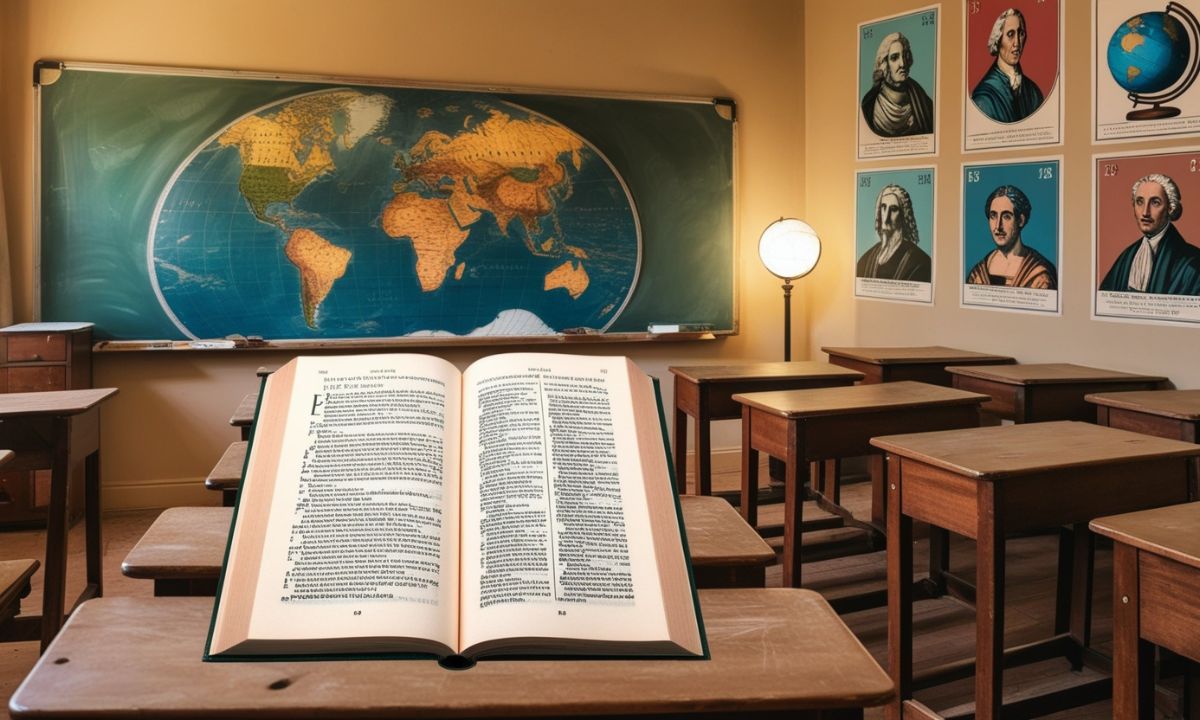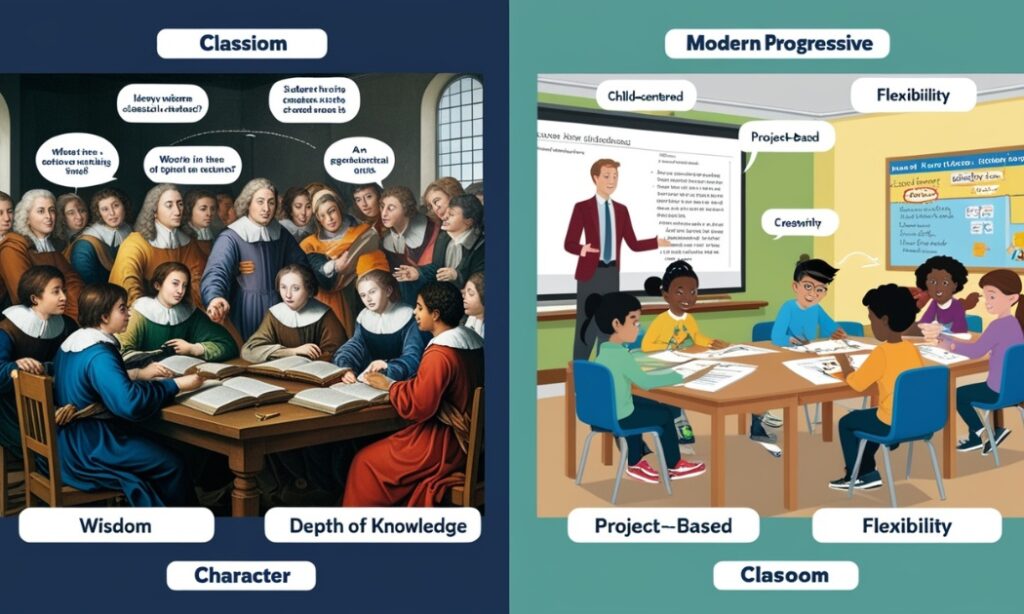While seeking various classical education, I was especially interested in one mode of education: classical. Classical cultural education is old-fashioned but still based on a well-worn template within a Western framework.
In this article, I will explain everything that makes up classical education, its functioning, and what it entails, especially for those nurses who desire to see this learning style in American schools exhorted classically.
The classical framework of learning, the classical curriculum, I will also narrow down to essential lessons and exciting findings that I have acquired in the process.
Key Takeaways
- Classical education relies on the use of the Trivium: Grammar, Logic, and Rhetoric stages to build critical and communicative competencies,, which is a model that has proven over time that it will that it will not fail in attaining its objective.
- This approach organizes the learners according to the student’s psychological development and growth patterns so that they do not remain at a static level of knowledge.
- The classical school provides a specific, distinctive curriculum that schematizes history, literature, philosophy, and ethics like no other.
- Classical education and curriculum stress learning of noble writing and civilization, that is, history, mathematics, philosophy, sciences, and Latin, along with the great learning books.
- Provides and gives healthier and way much stronger communication, critical thinking, moral reasoning, love of knowledge and learning forever.
Introduction to Classical Education
I never understood classical education (or any particular model, for that matter) or what defined that model. Classical education teaches students how to think, not simply remember – information is a bonus in the education process.
It seeks a broader than rote education and builds on the student’s abilities to think critically, reason, and persuade in a moral context.
This concept can be traced back to the educational practices of the ancient Greeks and Romans. It is still in practice,, for it helps to deepen the cognitive growth of an individual.
Defining Classical Education
- Grammar (Elementary Stage): The emphasis at this level is on the acquisition of knowledge, mainly through rote learning and a basic level of understanding.
- Logic (Middle School Stage): students start to ask questions and form conclusions by reasoning and linking pieces of information.
- Rhetoric (High School Stage): students are taught to present their views and ideas effectively.
How Classical Learning Works
From my experience, classical learning is designed to correspond with the progression of students’ cognitive development.
It’s pretty similar to a roadmap for learning in that it provides a sequence requiring one set of skills to be obtained before introducing more advanced ones.
The Trivium
| Stage | Age Range | Focus |
|---|---|---|
| Grammar | 5-11 years | Memorization, foundational knowledge, basics |
| Logic | 12-14 years | Analytical thinking, questioning, debate |
| Rhetoric | 15-18 years | Expressing ideas clearly, persuasive communication |
At any given point, learners progress by adding to previously mastered things. I find this method quite effective since it promotes not mere rote learning of facts but thinking and explaining more sophisticated constructs with time.
Classical Learning Techniques
- Socratic Method: This method can be described as an instructional style where questions elicit deep thinking instead of enlightening the learner. Instead of being passive receptors, students become active participants.
- Memorization and Recitation: As archaic as it may seem, I have realized that embedding critical phrases in the learners’ minds creates a mental foundation for their progression.
Classical Schools Explained
Americans, particularly parents whose children attend school in other parts of the country, are keen on classical education, often called classical schools. In my investigation, I found that these schools were usually private or charter schools.
What Makes Classical Schools Unique?
- Excellent Books Curriculum: Students attending classical academies must read primary sources of literature and philosophy. Some students may read Homer, Shakespeare, and Aristotle’s works.
- Moral and Character Education: In addition to the subjects offered, classical education focuses more on the construction of virtue, that is, one’s moral compass, discipline, will, and honesty, among others.
- Integration of Disciplines: Unlike the modern-day school curriculum, which we all know entails teaching students in different” classes” with no apparent links between them, a classical school ensures that literature, history, and science, among other subjects, are taught as integrated.
| Characteristic | Description |
|---|---|
| Great Books Curriculum | Students read classic texts from Western literature, such as Shakespeare and Plato. |
| Character Development | Emphasis on teaching students virtues and moral values. |
| Subject Integration | Encourages students to see how subjects connect, such as how ancient history influences literature. |
Critical Components of Classical Curriculum
There is a classical curriculum throughout classical education, and this curriculum is intended to enable the learners to acquire a knowledge base that is not only broad but also deep.
This curriculum includes core academic content subjects such as history and mathematics but includes areas uncommon in typical modern educational systems, like Latin and philosophy.
The Classical Curriculum in Detail
| Subject Area | Description |
|---|---|
| History and Literature | Focuses on studying Western civilization, including the works of great authors and historical events. |
| Mathematics and Science | These subjects are taught to develop logical reasoning and understanding of natural laws. |
| Latin and Classical Languages | Latin is often included to help students understand the roots of the English language and think logically. |
| Philosophy and Ethics | Students are taught to think about morality and what it means to live a good life. |
Benefits of Classical Education
Looking back on my journey to understanding classical education, I would like to say that it provides a great number of benefits.
That is not purely academic, these advantages also enable their holders become competent people outside studies.
Academic Benefits
- Critical Thinking: Classical education enhances deep analysis. It emphasizes logic and reasoning and teaches students how to think rather than what to think.
- Strong Communication Skills: There is an emphasis on rhetoric, thus preparing the students to express themselves articulately, whether in writing or speech.
- Interdisciplinary Knowledge: Learners can appreciate that different subjects are intertwined, which helps in expansive thinking.
Personal and Ethical Development
- Moral Education: I have seen that adherents of the classical educational system advocate moral values and the development of character. This allows the students to have some moral principles to adhere to.
- Lifelong Learning: To illustrate a significant advantage, classical education cultivates the desire to learn. It does not condition learners to complete exams and functions merely but always to be evaluative and inquisitive.
Modern Interpretations of Classical Education
In America, classical education has slowly crept back into the education system, emphasizing private institutions, homeschool associations, and charter schools in the past decade.
As classical education has become popular, it has devised ways of fusing the principles of classical education with today’s requirements, which is captivating.
Neoclassical schools got their founding principles from the historic educational systems, but they have been resourceful in finding ways of doing things differently today.
Blending Classical Education with Modern Technology
Technology has been one of the most significant advancements in incorporation within the modern classical languages of independent business interactions.
Ideally, classical schools practised text-based lessons and Socratic conversations and relied on canonical works to be read deeply. However, many changes are taking place due to integrating technology into the classical education system.
For example, Educational CDs, videos, computers, and other modern-day learning aids were designed to help. Such tools are handy for using primary sources in class, learning Latin, or having students participate in worldwide discussions in philosophy, history, etc.
Even if the textbook contains classical education ideas, it is evident that additional research needs to be conducted regarding children’s education. For instance, him-based learning may be effective but could be supplemented by more related tools.
The Rise of Classical Homeschooling
The modern classical education movement is interested in classical homeschooling. E-learning and liberal school schedules across the U.S. have made many parents decide to homeschool their children following a classical education.
Classical education at home is almost strictly Trivium-based, allowing for the division of education into phases focused on Lectio, ratio, and narration.
Flexibility in the Classical Model
Few programs or schools classified as classical peripherally incorporate STEM—science, technology, engineering, and math—subjects into the curriculum but also incorporate classical education principles.
To illustrate, students could learn how the mathematics of the Greeks and Romans was applied in their days before knowing how the same concepts are used in modern physics.
Comparing Classical Education with Modern Educational Models
An excellent way to understand the nature of classical education is to compare it with other standard educational practices. This aspect of classically orientated education makes it different from other types of education, which focus on developing wisdom, critical faculties, and character rather than merely resourcing knowledge.
Classical vs. Progressive Education
It has also been pointed out that there exists a difference between classical education and that commonly known as progressive education, which is a style found in most public schools today. Progressive education usually places the child at the centre of the education process, determining the curriculum based on their interests and experiences. It frequently incorporates project-based learning, cooperative learning, and flexibility in the learning environment.
Depth of Knowledge vs. Breadth of Knowledge
Focusing on matters such as the Great Books, primary source materials, and the history of the US enables the learners to drill down to a topic and do it well. Raganin: This way, gaps in time will be overcome, and deeper, more meaningful interactions with the material will be made possible.
In classical education, students do not only learn by being taught. Instead of touching the very superficial, they comprehend the ideas in multiple dimensions, usually learning through talking, arguing, and other intense assessments.
Preparing for College and Beyond
Another reason classical schooling has gained favour, particularly in high school,is because it allows students to go to college and learn or learn further than ordinary. In most cases, parents and even some teachers are now on board with how ordinary model academic work, such as higher teaching and learning activities, is enhanced.
Practical Examples and Case Studies in Classical Education
To enhance our comprehension of classical education theory, we can examine a few instances and case studies of particular schools and homeschooling environments that have embraced it.
Example: Highlands Latin School
Highlands Latin School in Louisville, Kentucky, is one of the illustrative classical schools in America.
Though it is not an elementary school, this institution implements the classical education method coupled with the Trivium-style education, further incorporating the study of Latin. Especially noteworthy is that Highlands Latin seeks to integrate modern resources while retaining classical principles.
Classical Homeschooling: The Well-Trained Mind Approach
The Well-Trained Mind is perhaps most attributable to classical homeschooling. This resource contains a complete classical curriculum for homeschooling and step-level advancements through the Trivium for different age levels of children.
Families using this approach tend to follow a very strict schedule, such as that provided by the structured program, which holds lessons daily in history, science subjects, mathematics, Latin, and literature.
The Timeless Appeal of Classical Education
Within the contextual scenery of how this model of education is embraced in the institutions and families in the United States and perhaps in other countries, there is something qualitatively different.
Where did classical education differentiate itself more than others? It aims to raise not just the knowledgeable but also the wise.
Such in-depth and systematic methods equip learners with crucial tools, such as logical, ethical, and reasoning skills, which are imperative in today’s work and social setting. It is a model that withstands the test of time, retaining its effectiveness while evolving in the face of new challenges.
My Opinion
If you consider the anxiety provided by applying various educational techniques for your child or indeed for yourself, classical education deserves special attention. It prepares students to be academically successful while nurturing their moral and emotional intelligence.
For instance, one can either enrol their child in a classical school or implement the principles of classical education using grammar school education in a home setting.


